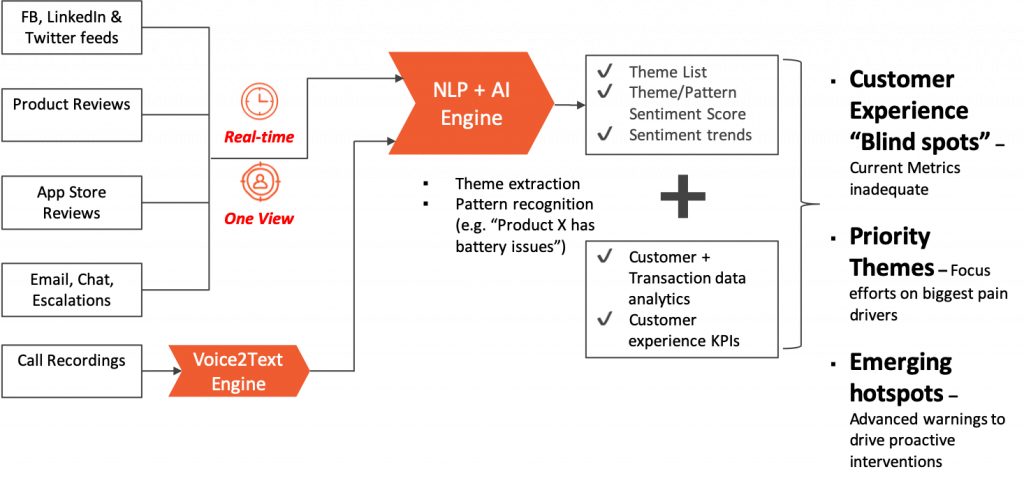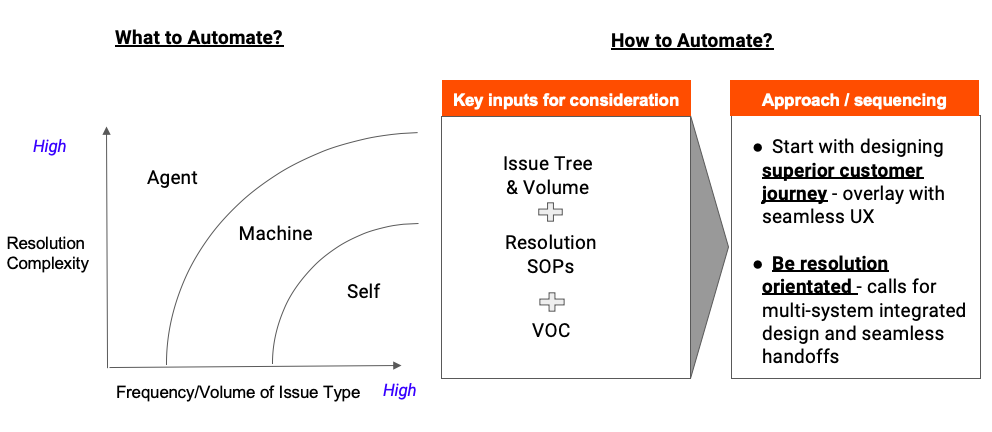Why do companies need to reimagine their customer service? And why do they need to learn from Digital Natives like Google, Amazon, etc.? That is because these digital natives are setting the standard for customer expectations – In a recent survey, when customers were asked which company would they want to take Telecom services from, 60% people responded Google or Amazon!
So what are the key differences in the way Digital Natives approach Customer Service?
- Fix at Source – While traditional organizations look to call deflection to save costs, digital natives believe that customer service indicates a customer pain point that should be fixed “at source”.
- Use Product Thinking and Tech to solve issues – Too many processes and policies at legacy organizations are driven by risk, legal and finance making them high friction. Digital natives, start with the voice of the customer to design the right customer experiences and use technology to manage risks
- Put AI and Technology at heart of everything – Not as siloed solutions to micro-problems but for driving end-to-end orchestration of customer experiences
To build next gen customer service capabilities, Incedo recommends 5 key initiatives:
- Use Voice of Customer to drive business priorities
- Fix root cause at source using Product Design Thinking
- Personalise Service Channel Mix
- Leverage AI to increase machine and self-serve digital channels
- Use Cloud based architecture to enable AI driven Customer Service at scale
Voice of Customer to drive business priorities
KPIs to optimize: NPS
Customers talk about products and service through multiple medium – they leave reviews on product pages, social media, App Store, etc., call care, write emails or escalate to senior management. Often, the focus of customer service teams is on “managing” these inputs – douse the fire if the review is negative. However, there is a wealth of information available in these customer inputs on what is working and what is not – the challenge is that there is a lot of noise and traditional approaches have been inadequate. Advanced NLP + AI techniques can help organizations extract very actionable insights from these VOC channels

Fix root cause at source using Product Design Thinking
KPIs to optimize: Calls/Incidents per Unit/Order
Most customer service issues require cross-functional approach and product design thinking to resolve at the root cause. For example, when faced with fraud most organization end up putting strong checks and balances in place that also add a lot of friction to genuine customer journeys. Digital natives, on the other hand approach it differently:
- They build robust tech and AI based preventive and corrective mechanisms and continuously refine them
- They take a ROI based approach – compensating customers for small ticket breaches rather than adding friction
Personalize Service Channel Mix
KPIs to optimize: NPS, CSAT
A recent study showed that digital channel leads to highest customer satisfaction for service. However, all customers are not equal and so are the issues they face. Personalization of service channel based on following key parameters is recommended:
- Customer lifetime value – High LTV customers expect white glove treatment best provided by high-quality agents
- Digital affinity – Forcing low digital affinity customers towards digital channels and vice-versa can lead to dissatisfaction
- Anxiety Levels – Some issues cause high anxiety, channels with best resolution rates if the customer is reaching out for these issues

Leverage AI to increase machine and self-serve digital channels
KPIs to optimize: Resolution Rate, MTTR (Mean Time To Resolution), Operating Cost
What should you automate or move to self-service? The choice should be driven by volume and resolution complexity of issues. High volume, low complexity issues lend themselves well to self-serve channel whereas high complexity issues will require human touch. Design of chatbot and self-serve solutions should begin with design thinking of customer journeys

Use Cloud based architecture to enable AI driven Customer Service at scale
KPIs to optimize: Time to Market
The solutions and approaches outlined in the previous 4 initiatives require building real-time AI/ML models that evolve continuously. Traditional data and technology architectures cannot keep up with the velocity of change and volume of data. Cloud based architectures are key to solving this problem given inherent scalability and vast & growing libraries of reusable components.
However, transforming existing legacy architectures to cloud based is a daunting task. Organizations can follow a 2-speed approach to this transformation:
- Speed 1: End to End Cloud transformation use case by use case
- Speed 2: Building out the cloud architecture that can support multiple use cases and future needs
In conclusion, customer service as most organizations know it is transforming and Digital natives are at the forefront. Leaders of traditional organizations can drive this transformation by undertaking 5 key initiatives that put the customer at the heart of the service – to begin this journey a cross-functional empowered team that can own and drive these initiatives is recommended. It is either that or slow death as customers abandon sub-par experiences for better ones.




